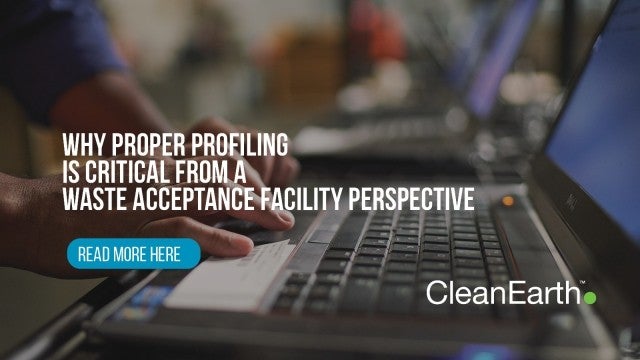Why Proper Profiling is Critical from a Waste Acceptance Facility Perspective

The partnership between a waste generator and a waste acceptance facility is a critical one; between ensuring hazardous waste is compliantly treated and disposed of and preventing any harm to people and the environment, the partnership benefits multiple parties. To get the most out of the partnership, however, it’s crucial that waste generators take measures to ensure proper profiling prior to reaching out to a vendor.
Prior to Partnering with a Waste Acceptance Facility
To mitigate waste in a partnership with a waste acceptance facility, consider the following:
Waste Acceptance Plans:
Every facility has a specific waste acceptance plan which outlines acceptance limits, criteria, and testing. Waste acceptance plans can vary state to state and facility to facility; two RCRA facilities in the same state can have completely different waste acceptance plans. The waste acceptance plan can clue you in to how many samples are needed, analytical data needed, and if QAQC testing is required.
Special Handling:
Material oftentimes will require special handling. The waste profile is where it’s key to signify any specific disposal outlets required.
Applicable Data:
Both process generation and waste classification information must be provided to any waste acceptance facility. This information explains the type of material and how it was generated to ensure its classified with the right waste codes. Sampling isn’t a catch-all, which is why waste acceptance facilities heavily rely on generators to provide as much detail and history as possible.
Sampling:
Every facility has a different frequency for sampling. Often there are a multitude of samples required, and its due to the lack of flexibility vendors have within their permits. When contacting a disposal vendor, vendors should provide a sampling frequency and sampling matrix for your use.
Underlying Hazardous Constituents:
It’s possible that your waste may contain underlying hazardous constituents that would dictate its end location. For example, if you have a soil that is hazardous for lead, there may be other hazardous constituents that prevent it from going into a landfill even after it’s treated for lead. Documents that can help you manage this include:
- Phase I/ Phase II Documents
- Waste Characterization Reports
- Contained In Letters
- Self-Implementing Clean-Up Plans
Impacts of Improper Profiling
Ultimately, responsibility for waste falls with the waste generator. However, inaccuracies in profiling can cause problems for all parties involved. Some complications can include:
Rejected Loads:
A rejected load is a headache for all parties and can lead to regulatory penalties. For example, let’s say a waste isn’t classified correctly and it’s shipped to a facility on a bill of lading. When it arrives on site, undergoes QAQC testing and results in a hazardous result, a regulatory penalty would be issued.
Fires and Reactions:
If waste is misclassified it can lead to dangerous reactions and fires. For example, a dangerous reaction can occur if a water reactive chemical is misclassified and mixed into the solidification process with water-based products. Fires and reactions then lead to site employee injuries.
While proper profiling requires a lot of information up-front, it’s designed to help mitigate risk in a partnership between a waste generator and waste acceptance facility. When partnering with Clean Earth, we ensure waste generators have all the information necessary to properly profile waste.
The information, content and materials provided in this Why Proper Profiling is Critical from a Waste Acceptance Facility Perspective blog and in related materials (“Content”) does not, and is not intended to, constitute legal advice, nor is it prepared by lawyer or law firm or as the product of any attorney-client relationship. Content is provided "as is;" no representations are made that the content is error-free. Content is available for general informational purposes only and may not constitute the most current legal or other information. Recipients of the Content assume all responsibility and risk arising from its use and reliance upon the Contact and should contact an attorney to obtain advice before acting or refraining to act on the Content. All liability with respect to actions taken or not taken based on the Contents is hereby expressly disclaimed.
